Discover how logistics automation transforms businesses through efficiency and scalability. Drawing from our experience, we’ll highlight benefits, key systems, and strategies to implement tailored solutions that drive success.
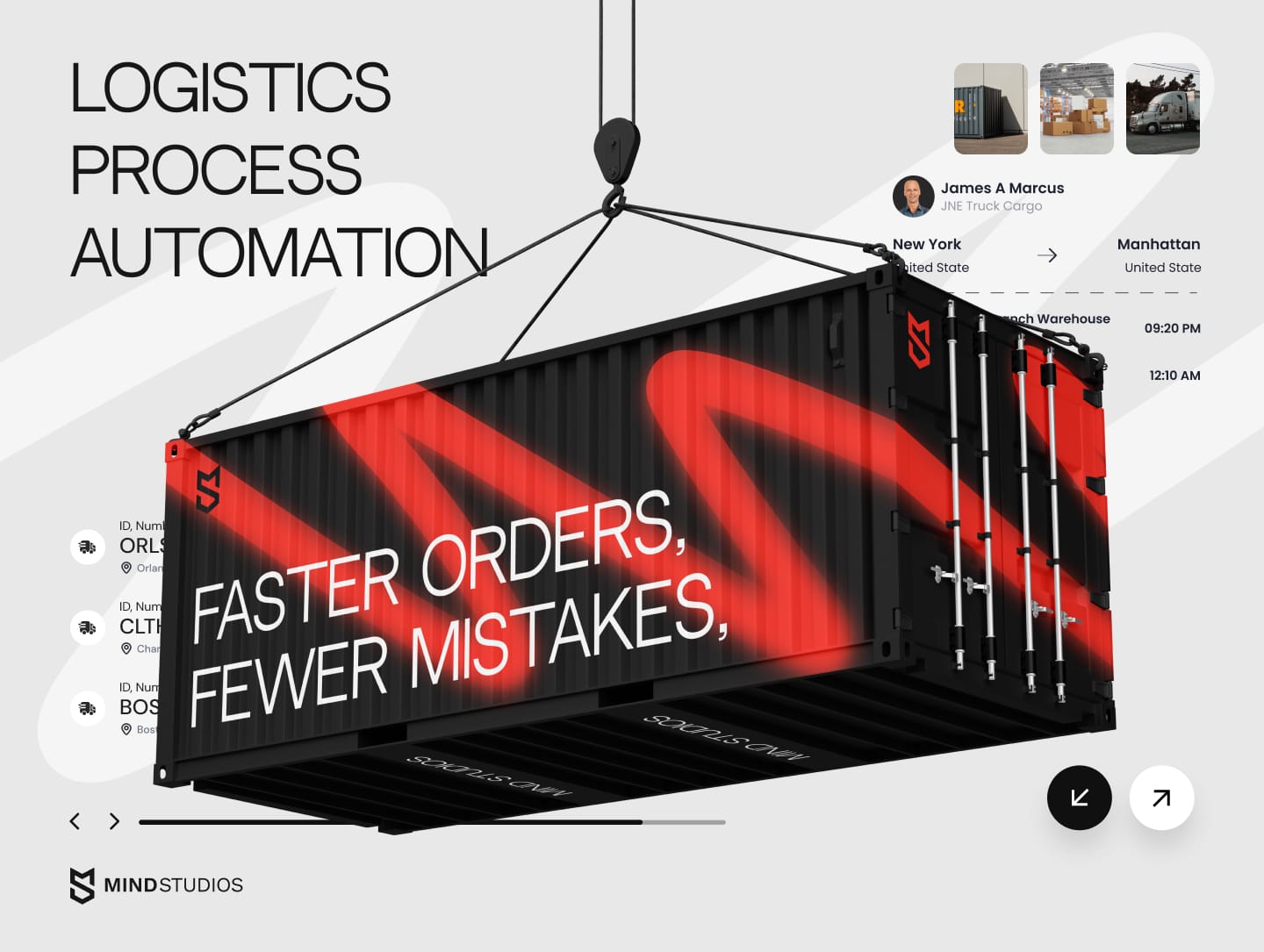
Recent years have forced logistics companies to reevaluate how they operate. Events like the pandemic exposed vulnerabilities in supply chains and underscored the need for greater efficiency and flexibility. Without automation in logistics, businesses often face costly delays, missed deliveries, and strained customer relationships, making it tough to stay competitive. As companies adapted to rapid changes, it became clear that automation and software solutions weren’t just a luxury — they were essential for survival.
At Mind Studios, we’ve observed that automation has become a lifeline for many businesses striving to stay competitive in today’s demanding logistics landscape. Companies are turning to technology to optimize processes, reduce costs, and meet customer expectations head-on.
For instance, when we developed Pampr a delivery service for vacationers, automation played a pivotal role. In just three months, the app facilitated over 1,000 weekly deliveries and cut operational inefficiencies by 25%, enabling the company to scale efficiently while maintaining top-notch service quality.

Highlights:
- Automation is the backbone of modern logistics, enabling businesses to adapt to rising demands and maintain their competitive edge.
- From pharmaceuticals to eCommerce, automation technologies adapt to diverse logistics challenges.
- Automation supports business growth by providing scalable solutions that keep operations running smoothly, even during peak demand.
Interested in learning more? Keep on reading to see how automation can help your business thrive in a competitive landscape.
Challenges and benefits of logistics process automation
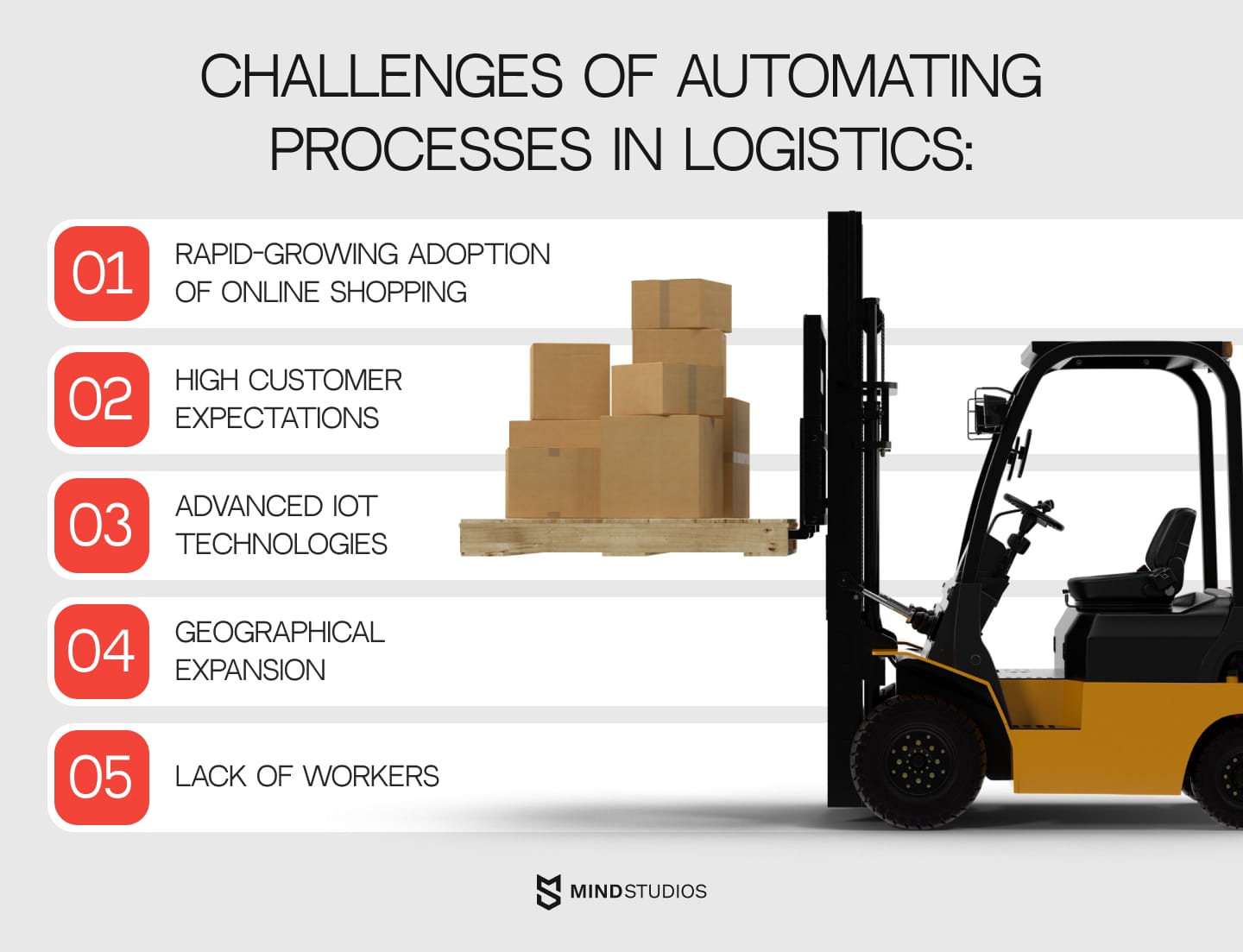
Before we get down to the factors that drive the industry, let’s determine what automation in logistics actually means and how it’s implemented.
Automation is one of the main driving forces in logistics. Shortly put, logistics automation means the adoption of digitalization and automation technologies in order to speed up logistics processes from procurement to distribution — and make them more efficient. The main tools to achieve that are control systems, automated machinery, and logistics software.
Logistics businesses face relentless pressure to optimize costs, improve transparency, and keep pace with growing customer demands. Automation is being adopted by nearly every second logistics business these days. If we were to be asked why automation, of all things, we'd say the following factors play the biggest role:
- Rapid-growing adoption of online shopping, has raised the pressure on logistics providers regarding quick and efficient order processing.
- High customer expectations, which include order accuracy and enhanced delivery services like real-time tracking, free returns, same-day deliveries, and so on.
- Advanced IoT technologies, as well as robotics and automation of logistics processes, becoming more accessible for small and medium businesses.
- Businesses’ drive for geographical expansion, which leads to more complex supply chain cycles.
- Lack of human workers, which is the direct result of constantly growing labor costs and a decreasing number of people who want to work in the warehouse environment.
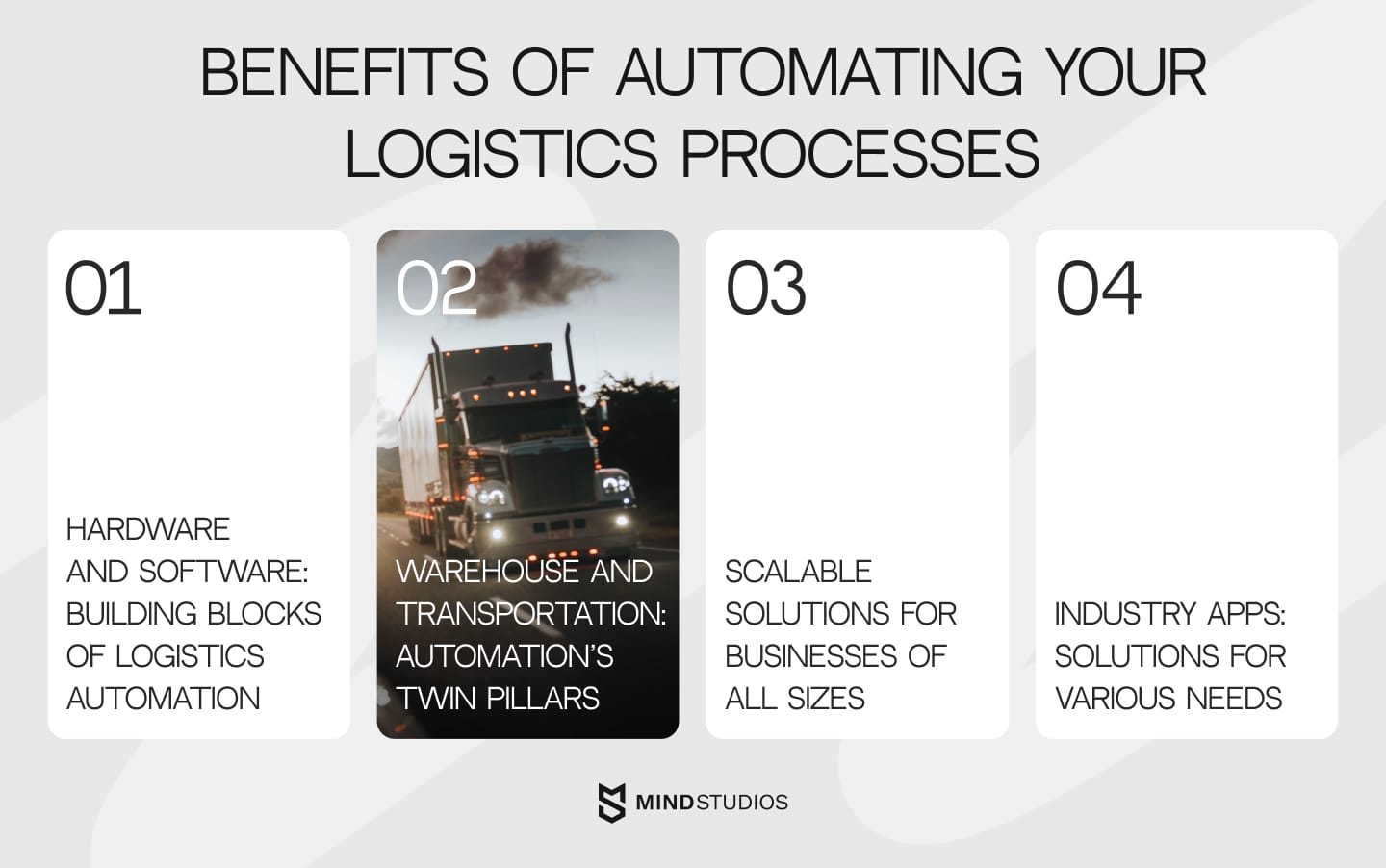
To address these growing challenges, logistics automation leverages advanced tools and industry-specific solutions to help businesses meet evolving demands effectively:
Hardware and software: Building blocks of logistics automation
Logistics automation thrives on the synergy between advanced hardware and intuitive software. Drones, automated vehicles, and robotic sorting systems streamline physical tasks, while software solutions like warehouse management systems (WMS) and real-time tracking ensure everything runs efficiently. All in all, this is what you can expect from adopting both hardware and software automation solutions:
- Drones and automated vehicles tackle routine or high-risk duties
- Warehouse management systems (WMS) automate stock control and order coordination
- Real-time tracking tools cut errors and boost reliability
- IoT data collection empowers better decision-making throughout the supply chain
Warehouse and transportation: Automation’s twin pillars
Warehousing and transportation are two critical areas transformed by automation. Automated storage solutions and robotic pickers boost warehouse productivity, while tools like route optimization and fleet tracking improve delivery accuracy. Together, they can enable businesses to operate with greater speed and lower costs, here is the quick breakdown:
- Automated storage and retrieval systems minimize time spent locating items
- Robotic pickers boost picking accuracy and reduce human errors
- Route optimization cuts fuel costs and speeds up deliveries
- Fleet tracking delivers real-time updates for proactive logistics management
Scalable solutions for businesses of all sizes
From basic barcode scanners for small firms to complex procurement and delivery automation, adding the analytical part for larger firms, automation is versatile. It makes the system efficient and functional for startups struggling to manage stocks or even large firms driving efficiency across their multiple outlets. So, this is what can you expect from adopting these automation methods:
- Basic barcode scanning works well for small firms with limited inventories
- End-to-end automation helps larger companies manage procurement and delivery efficiently
- Customizable analytics support diverse operational needs and resource levels
- Adaptable to both startups and enterprises aiming to expand their logistics capabilities
Industry-specific applications: Tailored solutions for diverse needs
Big firms and small businesses face very different challenges. Pharmaceuticals might require precise temperature controls for sensitive materials, while eCommerce companies depend on robust tracking and timely deliveries. Because each sector has unique requirements, industry-specific solutions are often essential for meeting operational demands without compromising performance. The main benefits include but not limited to:
- Pharmaceuticals can rely on precise temperature regulation for sensitive supplies
- ECommerce will be able to prioritize timely deliveries and transparent tracking
- Customized setups will be able to solve unique workflow challenges across sectors
- Focused features ensure core processes remain robust and aligned with business goals
Want to transform your supply chain with automation? Connect with Mind Studios, and we can find ways to make it happen together!
Tackling logistics automation challenges with proven solutions
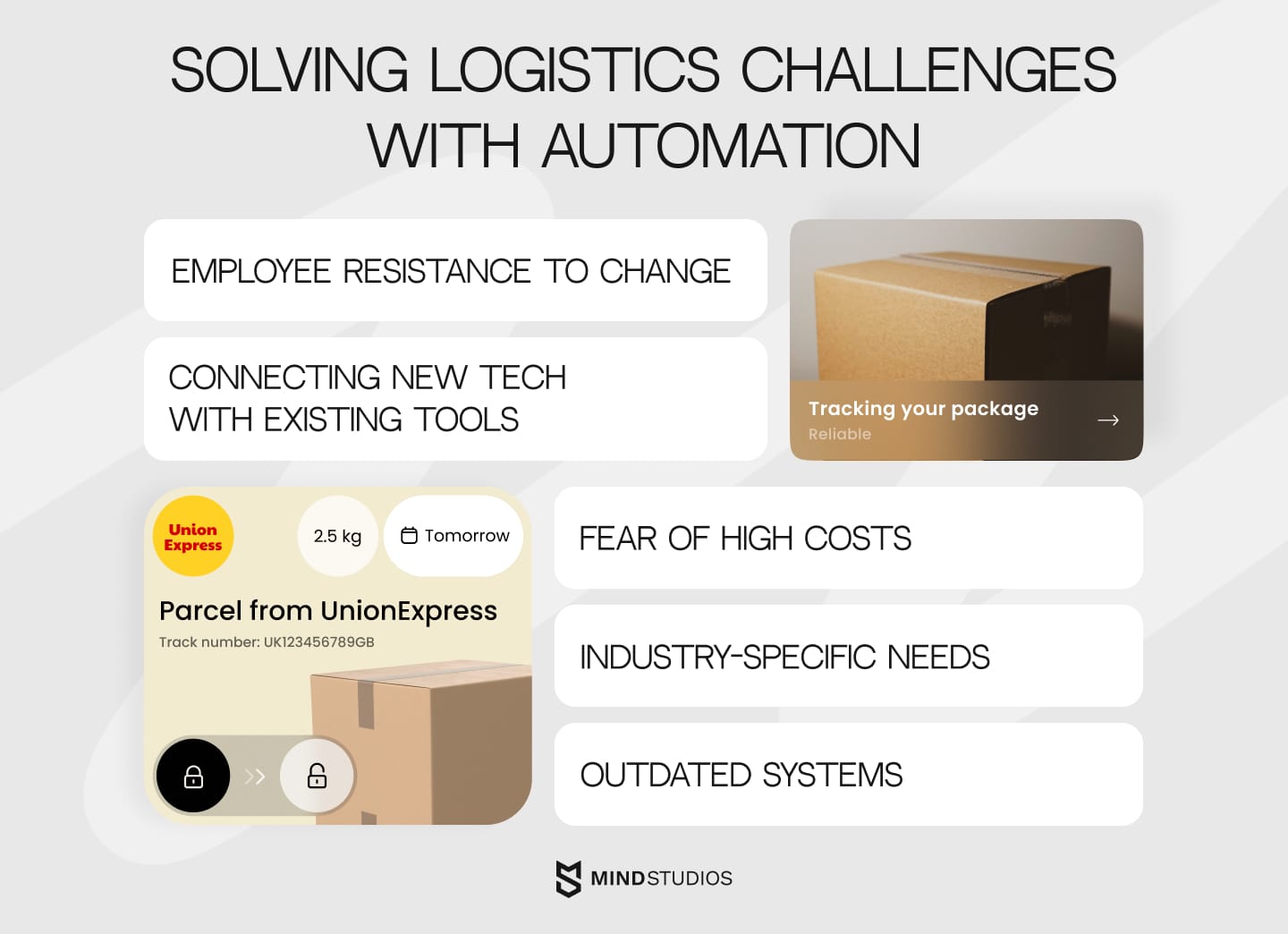
It is important to note that automation is not a remedy which can be applied universally. Each industry, and businesses within these industries, has their own constraints and challenges that need to be addressed individually. Temperature control in the delivery of pharmaceutical goods or visibility and control for eCommerce are the straightforward examples of where customized solutions matter most. But many businesses struggle when it comes to figuring out what kind of solution they need.
Now, let’s discuss the main challenges in automation of logistics and ways to solve them following effective practices.
Challenge: Getting a clear picture of existing processes
Sometimes, the biggest hurdle is knowing where to start. Without a clear understanding of current workflows, businesses risk automating the wrong things or missing key inefficiencies.
Solution: Take a step back and map out your processes. Identify pain points and areas where manual tasks slow things down.
Mind Studios example: With Pampr, we carefully examined their tipping and order management systems, pinpointing inefficiencies. By automating tip payments and centralizing their operations, we helped them streamline workflows and improve efficiency by 20%.
Challenge: Outdated systems that hold you back
Legacy systems can be like old furniture — they work, but they’re not built for growth or modern demands.
Solution: Focus on scalable systems that grow with you. They should integrate easily with what you already have, but allow room for expansion.
Mind Studios example: When building Medienlogistik’s transportation management system, scalability was key. The result? A platform that adapted to peak periods and reduced delivery times and costs by 15%.
Challenge: The fear of high costs
It’s easy to feel overwhelmed by the potential costs of implementing automation, especially when the ROI isn’t immediately clear.
Solution: Start small. Invest in modular solutions that address critical needs first, and scale up as you see results.
Mind Studios tip: Begin with essentials like real-time tracking or route optimization. They deliver fast, tangible results without breaking the bank.
Challenge: Potential employee resistance to change
Introducing new systems can feel like a culture shock, especially for teams used to manual processes.
Solution: Make the transition as smooth as possible with hands-on training and user-friendly tools.
Mind Studios example: For the James app, we designed intuitive dashboards and provided comprehensive training. This helped drivers and managers adopt the new system quickly and confidently, delivering fast ROI.
Challenge: Connecting new tech with existing tools
New systems are great — until they don’t work with what you already have. Integration hiccups can make automation feel more like a hassle than a useful tool.
Solution: Custom solutions are your best bet. They ensure seamless integration and minimal disruption to your operations.
Mind Studios example: This was one of the tasks we had to solve for M3Cargo, [describe what this company does]. They weren't planning to completely replace all systems, so we had to take that into account when building IoT-powered tools for their business. Currently, our tools work seamlessly with the other systems the company employs, enabling real-time shipment tracking without a hitch.
Challenge: Industry-specific needs
Every industry has unique challenges, from compliance in pharmaceuticals to temperature monitoring in food logistics.
Solution: Tailor your automation strategy to meet those specific needs. Generic solutions won’t cut it.
Mind Studios example: When developing the James app, we ensured compliance with food delivery regulations while adding features like real-time tracking, boosting customer satisfaction by 40%.
Automation doesn’t have to feel overwhelming. With the right approach and the right partner, you can turn challenges into opportunities. Selecting the right logistics app development company is a critical decision which builds the future of your business. A good partner is knowledgeable in your line of business and provides solutions that best suit that business and can easily grow with it.
Main automation tools to implement
Ultimately, the logistics industry is moving towards automating every process that can possibly be automated. However, for now, the most widespread digital solutions for logistics automation processes help solve the following tasks:
- Administrative work
- Warehouse operations
- Transportation and delivery management
- Order processing
- Customer relationship management
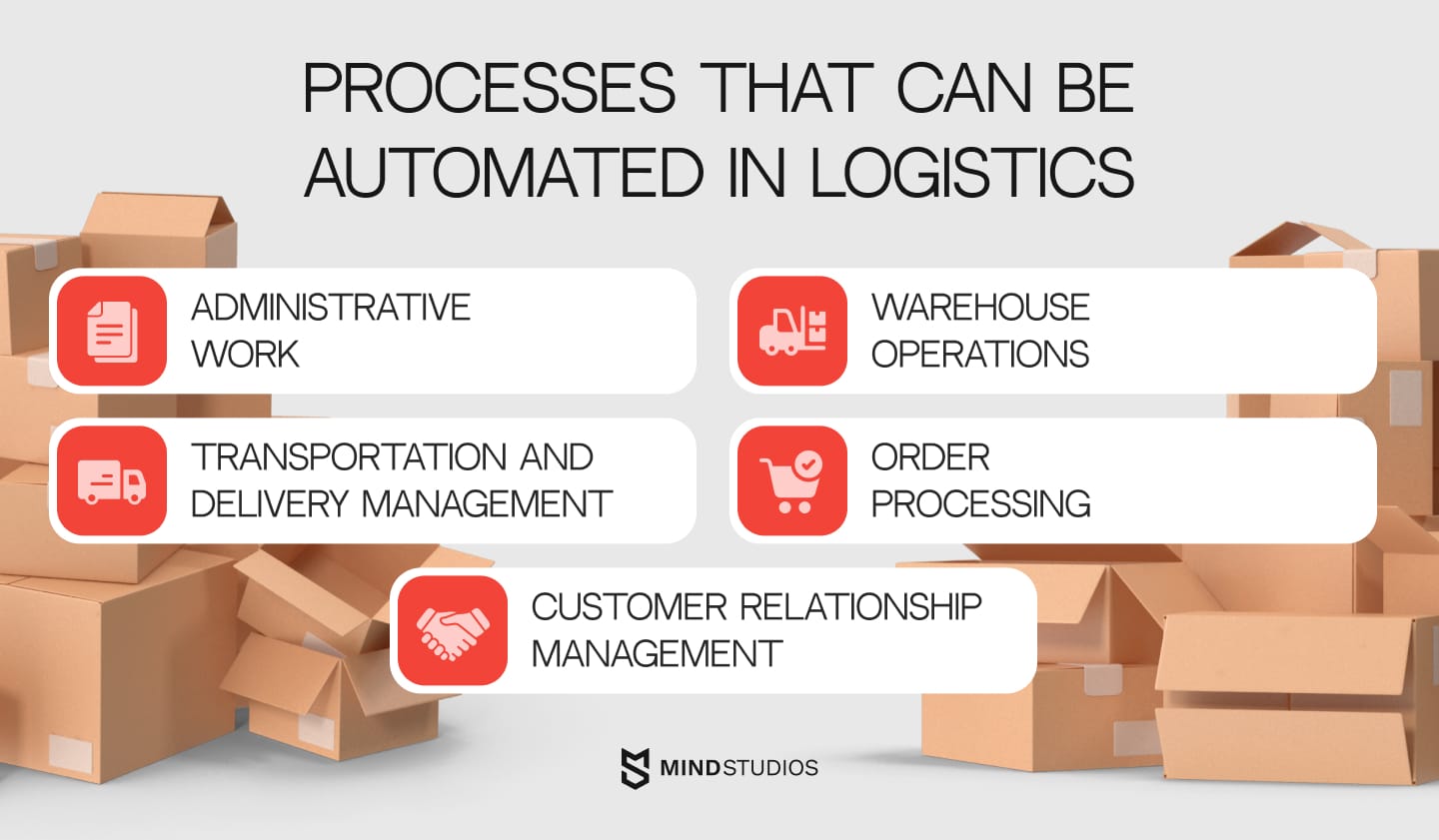
So, which logistics exactly automation systems can help your business with these tasks? Here are the most critical of them.
Manufacturing execution systems (MES)
What it is: Centralized software that organizes production data and processes, often syncing with ERP or CRM systems to align manufacturing output with broader company objectives.
Key benefits: Minimizes downtime, boosts product quality, and meets strict industry standards (e.g., automotive, pharmaceuticals).
Example: General Motors’ MES 4.0 tracks and optimizes real-time production, enabling faster, safer, and more efficient operations.
Warehouse management systems (WMS)
What it is: A system for inventory tracking, order handling, and resource optimization in warehouse settings.
Key benefits: Ideal for retail, eCommerce, and distribution, as it cuts errors and offers constant stock visibility, leading to more accurate deliveries.
Example: Amazon’s WMS uses robotics and AI to accelerate picking, packing, and shipping, even under high seasonal demand.
Transportation management systems (TMS)
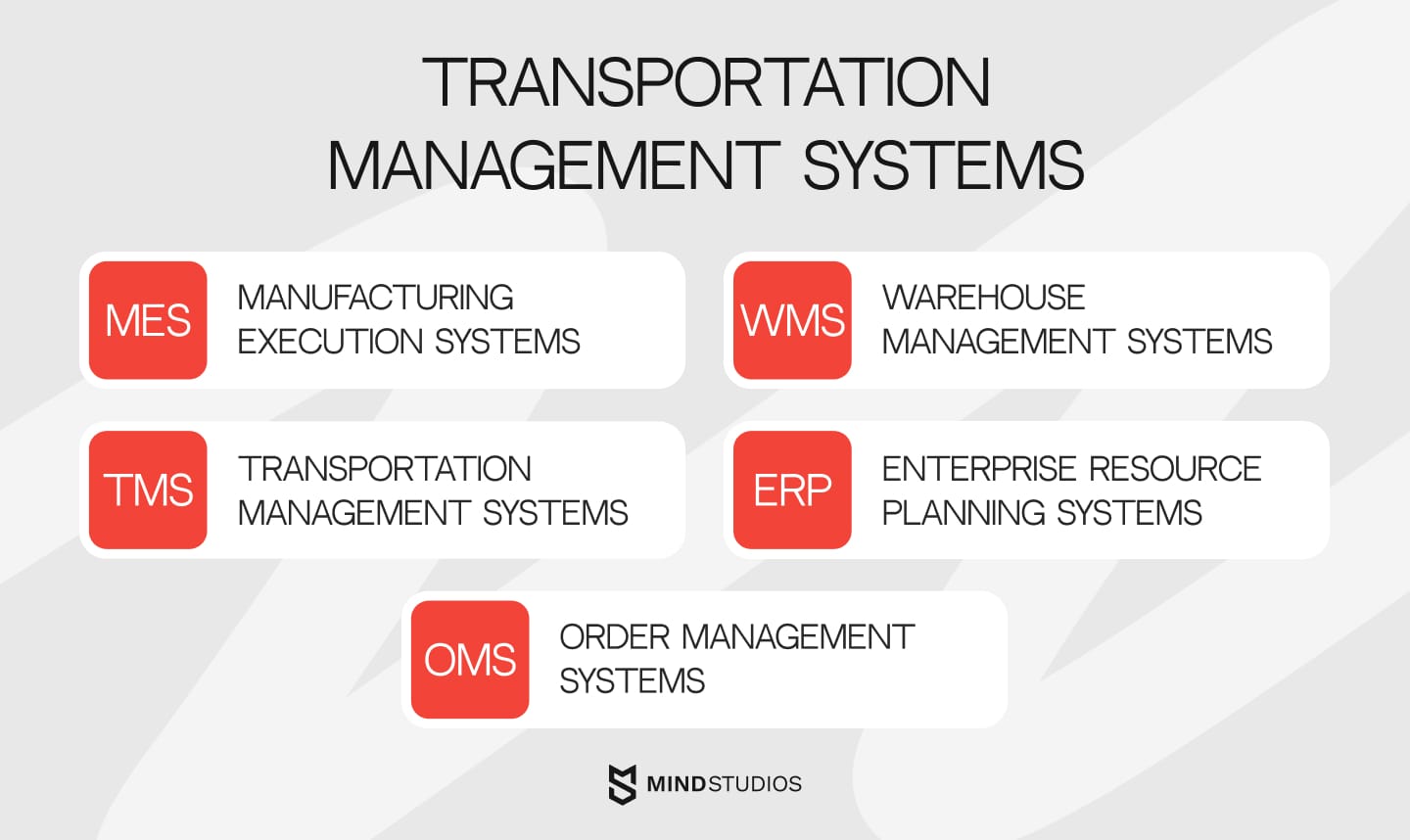
What it is: Software overseeing transport logistics in real time, covering route planning, load optimization, and shipment documentation.
Key benefits: Crucial for sectors like logistics, publishing, and retail, TMS lowers delivery times and costs by providing real-time insights for better decision-making.
Example: Medienlogistik’s TMS — developed by Mind Studios — offers live data for dynamic routing, cutting delivery times and transport expenses significantly.
Enterprise resource planning systems (ERP)
What it is: A platform uniting separate operational processes — finance, HR, supply chain — into a single, data-driven hub.
Key benefits: Perfect for manufacturing, logistics, and retail, ERP brings multiple functions under one roof, improves departmental collaboration, and reduces overhead.
Example: DHL supply chain uses Oracle ERP Cloud for better operational oversight, quicker decision-making, and less paperwork across its global network.
Order management systems (OMS)
What it is: Software to handle the entire order lifecycle, from receiving an order to its fulfillment.
Key benefits: Particularly useful in eCommerce and retail for automating order processing and inventory checks, boosting delivery speed and accuracy.
Example: Walmart’s OMS syncs stock between online and offline stores, smoothly managing millions of orders during peak seasons.
Predictive analytics systems
What it is: Tools that leverage historical and real-time data to forecast trends, reduce uncertainty, and optimize routes or inventory.
Key benefits: Essential for FMCG and automotive, where accurate demand forecasting and inventory management lower costs and improve decision-making.
Example: FedEx applies big data for route optimization and demand forecasting, cutting late deliveries by 30% and saving millions in operational costs.
If you think there has to be a better way to manage your business in order to run it more efficiently, we welcome you to contact us for a free consultation. Now, it is easier to build the best solution together.
A step-by-step guide on how to automate logistics processes
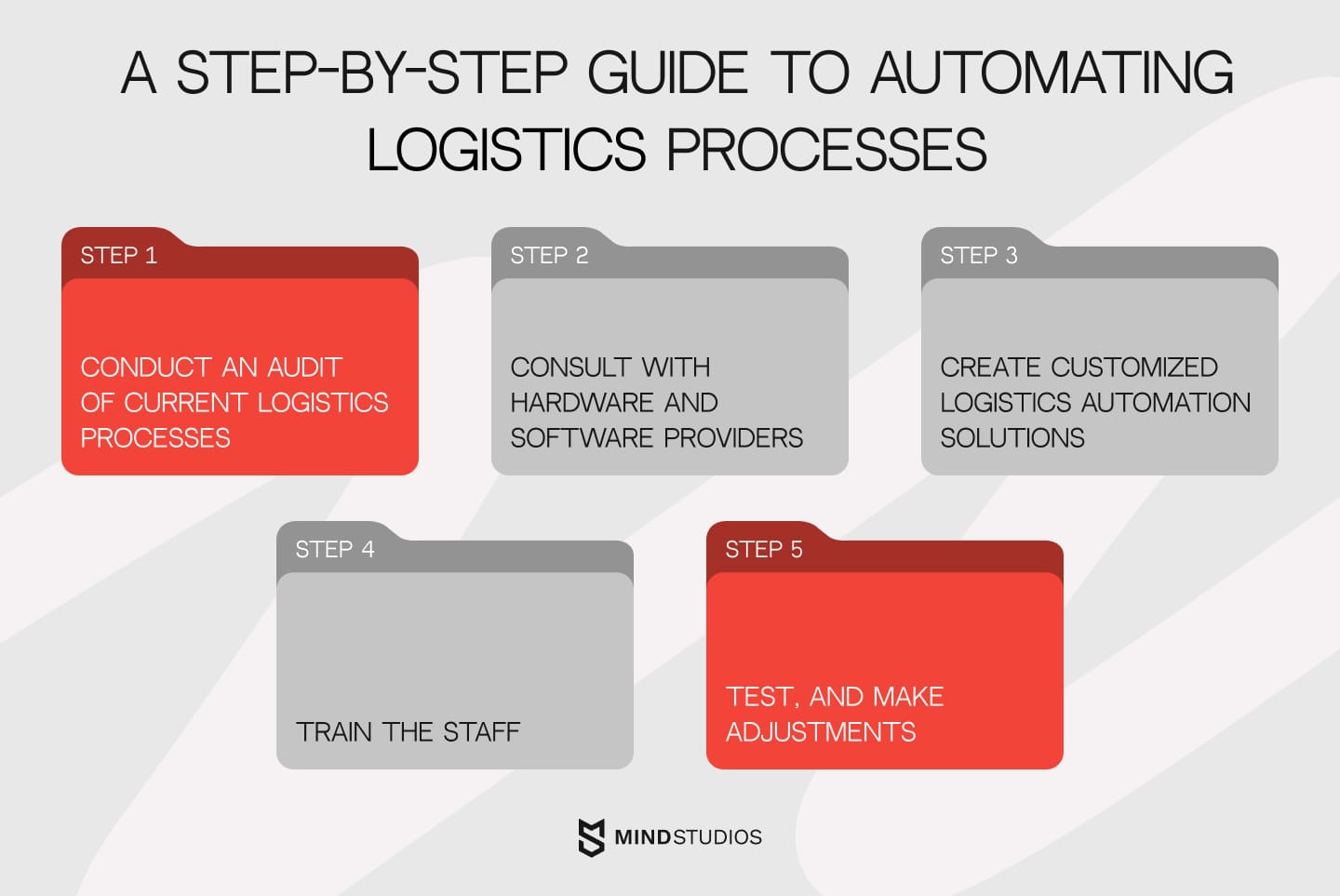
Now that we’ve determined that logistics automation is inevitable for any business pursuing growth, there are a few more questions to answer: Where should you start? And what do logistics automation processes actually look like? These five steps will help you get a better understanding of the process.
Step 1. Conduct an audit of current logistics processes
As a business dealing with logistics, chances are some of your processes are already digitalized. At this stage, you need to review how efficient these solutions are, how well they are connected to each other, and which processes your team is still doing manually.
Conducting an audit will help you determine the pain points of your business — and thus make it easier to prepare the requirements for the next stage.
Step 2. Consult with hardware and software providers
Now that you know what challenges your business needs to tackle, you can look for partners to help you do that.
As we have worked with clients such as Medienlogistik and Pampr delivery service, we know the requirements of logistics and are able to design solutions that are easily integrated into business processes. This experience makes us capable of handling problems and achieving goals.
For example, as a software development company, Mind Studios can help to design plans on how to implement automation solutions like a warehouse or a fleet management system that is backed by powerful analytical tools. Also, we provide auditing services as well as upgrade services for existing software to make it perform optimally.
Step 3. Create and implement customized logistics automation solutions
At this point, all you need to do is delegate the task to the hardware and software development agencies. During this stage, they will provide the solutions, tailor them to the specific needs of your company, and integrate them into your logistics processes.
With Mind Studios, this process is highly customized and very hands-on. Our approach is to collaborate with a client to develop solutions that will fit their business needs, integrate well, and grow with the business. Communication is the foundation of all the projects that we undertake as a company.
Step 4. Train the staff
The next step is to teach your staff how to operate the implemented systems.
For instance, this might include operating management systems, maintaining the hardware, processing the results of data analysis, communicating with development partners, as well as working with feedback from the clients, and looking for what could be improved.
Step 5. Test and make adjustments
Once the solutions are up and running, you will need to monitor their performance and report on any problems or challenges you run into. The hardware and software partners will make adjustments accordingly to make sure the systems run like clockwork.
Navigating logistics automation without a clear action plan can be overwhelming. Partnering with experts ensures that your automation strategy aligns perfectly with your business needs.
Want to get an evaluation of your processes? Contact us, and let’s build an action plan together!
Real examples of profitable logistics process automation
Mind Studios has developed dozens of web and mobile solutions for businesses in various industries. Naturally, some of them were connected to the logistics sector. Here, we share a couple of logistics automation solutions our team is especially proud of.
James: Crafting a dual-app solution for Denmark’s food delivery industry

When developing James, a delivery app for the Danish market, our focus was on automating and optimizing key processes to meet tight deadlines and deliver a high-performing solution. The project required creating four app versions — for buyers and shoppers on both Android and iOS — all within a challenging 3-month timeframe.
How we automated processes
The core of our approach revolved, you’ve guessed it, around automation:
- For buyers: We implemented features like real-time order tracking, automated payment processing, and streamlined shopping list creation. These eliminated manual input and reduced delays, ensuring a seamless user experience.
- For shoppers: Automation tools such as GPS-based work zone setups and real-time order updates allowed drivers to optimize routes and handle deliveries efficiently.
Key results
Despite the challenging development timeline, the app achieved impressive results shortly after launch:
- Efficiency gains: Enabled over 1,500 weekly deliveries, cutting inefficiencies by 30%.
- User adoption: Positive feedback highlighted the app’s reliability and ease of use.
- Future-proofing: Modular development allowed for scalability, setting the stage for continued growth and feature expansion.
By prioritizing automation, the James app not only met its KPIs but also laid the groundwork for scalable, efficient logistics operations. This case showcases how a focus on automating processes can overcome challenges and deliver impactful results.
Pampr: Optimizing and streamlining luxury delivery services

Pampr, a luxury delivery service based in Nantucket, approached us with a need to streamline and automate key operations, including tipping, order management, and administrative oversight. The goal was to enhance operational efficiency without shifting the management's focus away from delivering the premium experience Pampr's clients expect.
How we automated the processes
Just like with James, automation was central to the solution we developed for Pampr:
- Automated tipping system: We introduced a system where each butler had a dedicated Stripe account. This ensured that tips were automatically deposited directly into their accounts, bypassing the main business account, resulting in faster and more transparent payment processing.
- Centralized CRM system: The CRM integrated all aspects of butler management, from tracking performance to automating salary adjustments and payment distribution.
Key results
The automation significantly improved Pampr’s operations:
- Efficiency boost: Processed over 1,000 orders during the first summer season, saving customers more than 2,000 hours.
- Customer loyalty: The platform fostered a base of 560+ regular users in the first 2 months after launch.
- Scalability: The streamlined processes laid the foundation for expansion into new markets.
This case highlights how tailored automation can simplify complex operations, positively affecting service quality, driving growth, and preparing businesses for the future.
Mind Studios’ expertise isn’t limited to these projects, though. Our team develops software solutions like warehouse, inventory, and fleet management systems, monitoring & analytics software, cargo transportation tracking and route planning solutions, and other custom systems for businesses.
Still unsure if you need to automate your logistics processes? Contact our experts, and we'll look into your situation and analyze the possible points for automation.
Conclusion
Automation doesn’t only apply to the flow of goods; it is about designing mobility for businesses in today’s complex world. With the correct tools and systems, companies can foster productivity improvements, secure insightful information, and act proactively based on changes within the industry.
Of course, automation is not all about technology, it is a roadmap designed according to the problems and opportunities from the business’s standpoint. In this case, partnering with experts can ensure you achieve the maximum return on investment.
Ready to take your logistics processes to the next level? Contact our team for a free consultation, and let us help you design solutions tailored to your business goals.

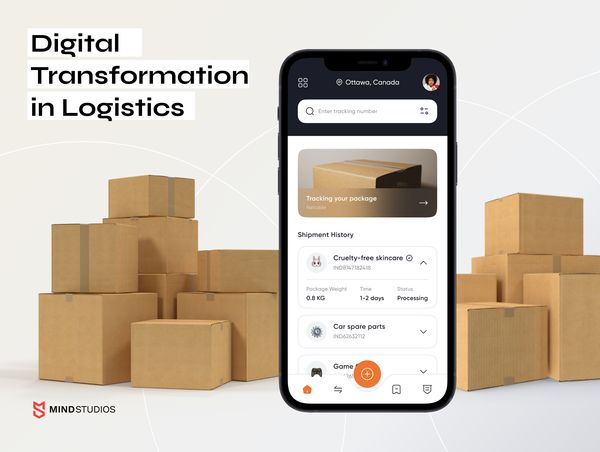


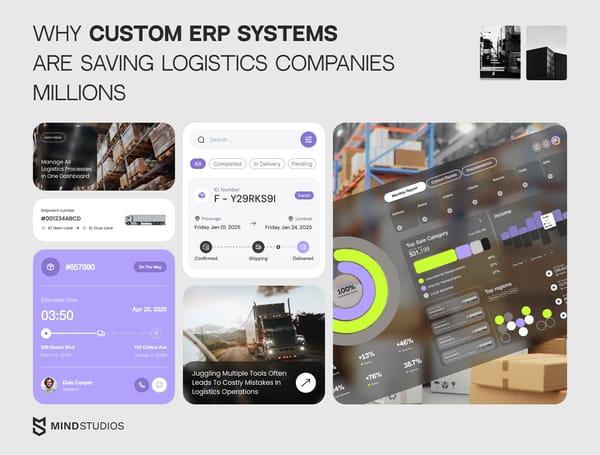
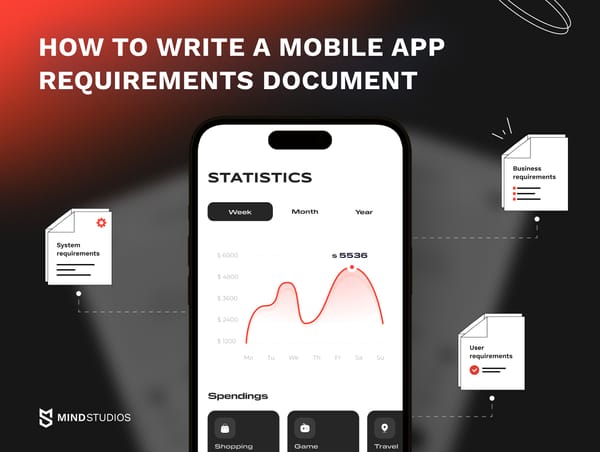
![How to Create an On-Demand Medicine Delivery App [Expert Guide]](https://themindstudios.com/blog/content/images/size/w600/2025/03/IMG-1-Cover-6.jpg)

